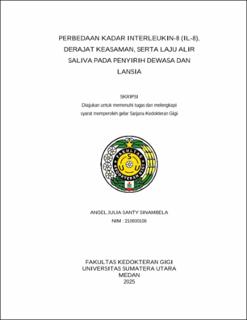Perbedaan Kadar Interleukin-8 (Il-8), Derajat Keasaman, serta Laju Alir Saliva pada Penyirih Dewasa dan Lansia
Differences of Interleukin-8 (IL-8), pH, and Salivary Flow Rate in Adult and Elderly Betel Chewers

Date
2025Author
Sinambela, Angel Julia Santy
Advisor(s)
Primasari, Ameta
Metadata
Show full item recordAbstract
Betel chewing is a tradition passed down through generations and is known to affect oral health by altering saliva acidity, salivary flow rate, and inflammatory responses measured by IL-8 levels. This study aims to compare the levels of Interleukin-8 (IL-8), acidity, and salivary flow rate in adult and elderly betel chewers. The research method used was an analytic comparative design with a cross-sectional approach. The study population consisted of adult betel chewers aged 18-44 years and elderly betel chewers over 60 years old. A total of 40 subjects were selected using purposive random
sampling based on inclusion and exclusion criteria. Saliva was collected using the passive drool method, and the acidity and salivary flow rate were measured using a pH Spear meter and a digital scale. IL-8 levels were analyzed using the Enzyme-Linked Immunosorbent Assay (ELISA) method. The results showed that the pH in adult betel chewers were 7,05±0,56, while in the elderly betel chewers, they were 6,49±0,30
(p=0,003). The average salivary flow rate in adult was 0,26±0,11, whereas in the elderly, it was 0,19±0,08 (p=0,048). Additionally, the average IL-8 levels in adult betel
chewers were 11,59±7,96, while in the elderly, they were 27,92±30,51 (p=0,048). These results indicate significant differences in acidity, salivary flow rate, and IL-8 levels between adult and elderly betel chewers. The conclusion of this study is that age affects saliva pH, salivary flow rate, and IL-8 levels in betel chewers. Therefore, special attention is needed for the oral health of elderly individuals who have a habit of betel chewing to reduce the risk of inflammation and oral diseases.
Collections
- Undergraduate Theses [1908]
